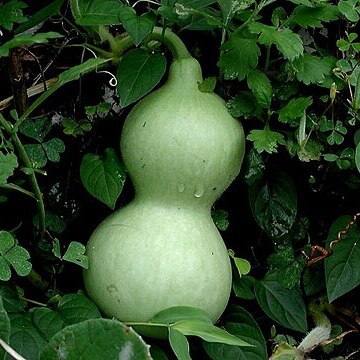Robust annual (or perennial) climbing herbs, leafy stem 2-5 mm diam., plant finely hairy; monoecious (or dioecious). Probract absent (or present, not in Asia). Tendrils (unbranched or) 2-branched. Leaves: petiole long, usually with a pair of glands at apex; blade simple, unlobed or lobed. Flowers solitary, large; petals white, free. Male flowers: pedicel long; receptacle-tube campanulate or elongate; sepals narrow; petals obovate, margin entire or ± crisped; stamens 3, filaments free, inserted on the tube towards the base, anthers coherent but free, two 2-thecous, one 1-thecous, thecae plicate and often also much contorted, connective broad; disc present. Female flowers: pedicel shorter than in male flowers; ovary hairy, ovules numerous, horizontal; perianth as in male flowers, but receptacle-tube short; style short, stigma deeply 3-lobed or consisting of 3 subsessile parts, each ± entire or 2-lobed; disc absent; staminodes small. Fruit ripening green or yellowish, large, hard-shelled, inside fleshy, indehiscent. Seeds numerous, compressed, margin ± distinct, edge entire.
Strong-growing herbaceous climbers or trailers. Leaves simple; petiole with a pair of apical lateral glands. Tendrils proximally bifid, or sometimes simple. Flowers large, white, opening in the evenings, monoecious or dioecious. Male flowers solitary or racemose; receptacle-tube obconic to long-cylindrical; lobes narrow, relatively small; petals 5, free, entire; stamens 3 (2 double 2-thecous, 1 single 1-thecous); filaments free, inserted on the tube; anthers free but often coherent; connectives broad; thecae triplicate and usually also much contorted. Female flowers solitary; ovary hairy; ovules many, horizontal; receptacle-tube very short; stigma 3-lobed, Fruit large, greenish, terete, hard-shelled, fleshy, indehiscent. Seed compressed, oblong or ovate-oblong in outline, smooth, somewhat 2-horned at one end and tapered at the other; faces each with 2 flat submarginal ridges approaching one another at each end. Fig. 6.
Annual, monoecious, tendriled vines; stems 5-to 10-sulcate. Leaves petiolate, simple; petiole biglandular at the apex; tendrils 2-branched. Staminate flowers solitary, long pedunculate; hypanthium narrow campanulate or funnelform; calyx 5-lobate; petals 5, white, free to the base; stamens 3, borne on the hypanthium wall, the filaments free, the anthers free or slightly connate, 1 unilocular, 2 bi-locular, the theca flexuous; pistillodium glandiform. Pistillate flowers solitary, axillary; hypanthium tube cupuliform; corolla as in the staminate; ovary ovoid to cylindrical, 3-carpellate, the ovules numerous, horizontal, the style short, thick, the stigmas 3, bilobate thick; staminodia 3, minute. Fruits yellowish or whitish, variable in shape and size, usually large, indehiscent, the cortex woody, the flesh spongy; seeds white, obovate to triangular, compressed, marginate, the apex truncate or bidentate, rarely rounded.
Monoecious climbing or trailing annual herbs, pilose or pubescent with simple hairs. Tendrils 2-branched. Leaves simple, dentate, undulate; petiole bearing 2 glands at top. Flowers large. Male flowers solitary; hypanthium campanulate, cylindrical; calyx 5-lobed, the lobes linear to narrowly triangular; corolla deeply 5-lobed or of 5 free petals; stamens 3, inserted at base or middle of hypanthium; connective broad; anthers free or cohering, two bilocular, one unilocular; locules flexuose, triplicate, usually contorted; disc absent or gland-like. Female flowers solitary; hypanthium shorter than males; staminodes 3, minute; ovary ellipsoidal to cylindrical-ellipsoidal; ovules many; stigmas 3, bilobed. Fruit large, variable in shape, usually subglobose, ovoid or ellipsoidal, fleshy, indehiscent, hard-skinned. Seeds many, ovate to oblong, truncate, compressed.
Herbs, scandent, softly pubescent. Tendrils 2-fid. Petiole apex 2-glandular; leaf blade ovate-cordate or reniform. Plants dioecious or monoecious; flowers solitary or male flowers in racemes, white. Male flowers: pedicels elongate; calyx tube narrowly campanulate or funnelform; segments 5; corolla segments 5, oblong-obovate, apex retuse; stamens 3; filaments free; anthers included, slightly coalescent or free, oblong, one 1-celled, others 2-celled; anther cells sigmoid-flexuous; connective not produced; pistillode glandular. Female flowers: pedicels short; calyx tube cupular; calyx and corolla as in male flowers; ovary ovoid or cylindric; ovules numerous, horizontal; placentas 3; styles short; stigmas 3, 2-lobed. Fruit polymorphic, indehiscent, fleshy, woody when mature. Seeds numerous, obovate, compressed, distinctly marginate.
Stamens 3, 2 double two-thecous, 1 single one-thecous, free; filaments inserted on the receptacle-tube; connectives broad; thecae flexuous.
Female flowers solitary; receptacle-tube extremely short, perianth otherwise similar to that of male flower; stigma 3-lobed.
Seeds compressed, oblong or ovate in outline, the faces with two flat submarginal ridges.
Receptacle-tube obconic to cylindrical; lobes remote, narrow, usually glandular.
Flowers large, white, monoecious or dioecious, opening in the evenings.
Fruit greenish, terete, hard-shelled, fleshy, indehiscent.
Leaves simple; petiole with 2 apical lateral glands.
Petals 5, free or nearly so, entire.
Male flowers solitary or racemose.
Tendrils proximally 2-fid.
Vigorous scandent herbs.

